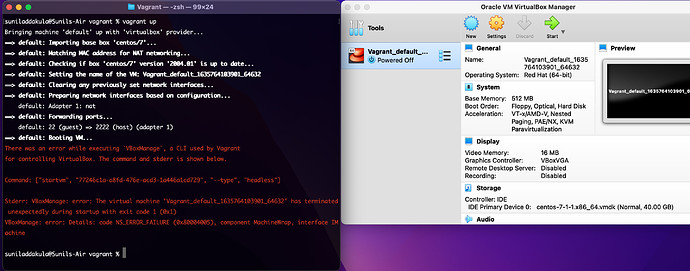I have installed vagrant and then created/initialized vagrant file. This step was successfully completed but when the VM has to be created with the “vagrant up” command, it showed up with this error. I can see a VM has created initially in VirtualBox but the error showed up while the boot process was going on. I am guessing it is something with the VirtualBox. Help with solutions. Thank you.
Here is the vagrant file
-- mode: ruby --
vi: set ft=ruby :
All Vagrant configuration is done below. The “2” in Vagrant.configure
configures the configuration version (we support older styles for
backwards compatibility). Please don’t change it unless you know what
you’re doing.
Vagrant.configure(“2”) do |config|
The most common configuration options are documented and commented below.
For a complete reference, please see the online documentation at
https://docs.vagrantup.com.
Every Vagrant development environment requires a box. You can search for
boxes at Discover Vagrant Boxes - Vagrant Cloud.
config.vm.box = “centos/7”
Disable automatic box update checking. If you disable this, then
boxes will only be checked for updates when the user runs
vagrant box outdated. This is not recommended.
config.vm.box_check_update = false
Create a forwarded port mapping which allows access to a specific port
within the machine from a port on the host machine. In the example below,
accessing “localhost:8080” will access port 80 on the guest machine.
NOTE: This will enable public access to the opened port
config.vm.network “forwarded_port”, guest: 80, host: 8080
Create a forwarded port mapping which allows access to a specific port
within the machine from a port on the host machine and only allow access
via 127.0.0.1 to disable public access
config.vm.network “forwarded_port”, guest: 80, host: 8080, host_ip: “127.0.0.1”
Create a private network, which allows host-only access to the machine
using a specific IP.
config.vm.network “private_network”, ip: “192.168.33.10”
Create a public network, which generally matched to bridged network.
Bridged networks make the machine appear as another physical device on
your network.
config.vm.network “public_network”
Share an additional folder to the guest VM. The first argument is
the path on the host to the actual folder. The second argument is
the path on the guest to mount the folder. And the optional third
argument is a set of non-required options.
config.vm.synced_folder “…/data”, “/vagrant_data”
Provider-specific configuration so you can fine-tune various
backing providers for Vagrant. These expose provider-specific options.
Example for VirtualBox:
config.vm.provider “virtualbox” do |vb|
# Display the VirtualBox GUI when booting the machine
vb.gui = true
# Customize the amount of memory on the VM:
vb.memory = “1024”
end
View the documentation for the provider you are using for more
information on available options.
Enable provisioning with a shell script. Additional provisioners such as
Ansible, Chef, Docker, Puppet and Salt are also available. Please see the
documentation for more information about their specific syntax and use.
config.vm.provision “shell”, inline: <<-SHELL
apt-get update
apt-get install -y apache2
SHELL
end
